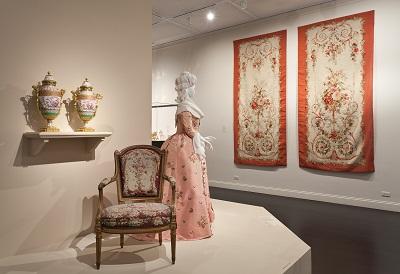Although costume and textiles are managed by one curatorial department at LACMA and decorative arts by another, these collections can include objects that relate closely to one another with respect to color palettes, design sources, and decorative motifs. The robe à l’anglaise (English-style gown) and pair of Aubusson tapestries currently on view in Gallery 310 on the third floor of the Hammer Building reveal similarities with French porcelain and furniture in the second half of the eighteenth century.
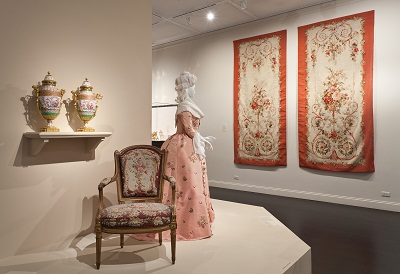
View of the Aubusson tapestries and a robe à l’anglaise newly installed with the pair of potpourri porcelain vases and armchair
Upon entering the gallery, the vibrant color palette shared among the tapestries, dress, furnishing fabric of the armchair, and pair of porcelain potpourri vases is immediately noticeable. The room glows with radiant hues of crimson, rose, salmon, magenta, and fuchsia, accompanied by a range of greens. The curvilinear vines, tendrils, and foliage seen in the textiles and decorative arts on display were shared motifs popular in the period.
The tapestry panels displayed on the wall were made by weavers in Aubusson, a medieval town in central France known since the fourteenth century for its finely woven tapestries. In 1665, the tapestry workshop was granted the right to mark their works “Manre [Manufacture] Royale d’Aubusson” by King Louis XIV. Woven into the bottom edge of both tapestries on display are the words which identify the workshop, along with the 1762 date of production.
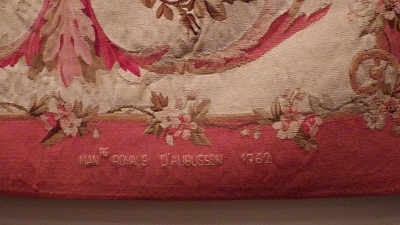
Detail of the bottom of one tapestry
At the time the tapestries were woven, the European aesthetic was beginning to transition from the rococo style—known for unrestrained ornament based on organic motifs derived from nature—to the neoclassical style, spurred by the early eighteenth-century archaeological discoveries in Pompeii and Herculaneum. The Neoclassical style first gained prominence in Europe in the 1760s, combining motifs, forms, and subjects from classical Greek and Roman vocabulary. Elements of both styles are evident in all of these objects on display.
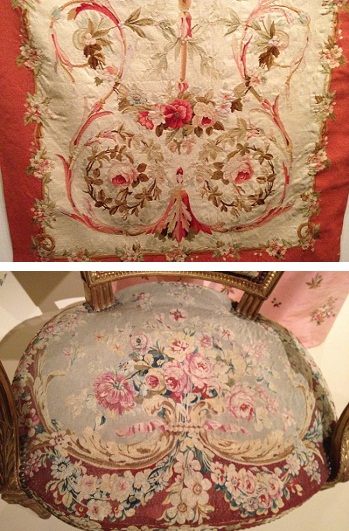
Top: Detail of the tapestry motif; bottom: Detail of the armchair seat motif
The tapestries are decorated in a bold rococo aesthetic with a pair of scrolls made of garlands of flowers with large pink roses. A similar design is present in the woven textile that covers the seat of the armchair. Although the shared floral motif and color palette in the tapestries and furnishing fabric lean toward the rococo style, the decorations in each are symmetrical and captured within a floral border, two characteristics of the neoclassical style.
The golden threads that are woven to form the two-tone scrolls in the hanging tapestries and on the armchair’s furnishing fabric mimic the carved metallic-gilded wood frame of the armchair, as well as the gilded bronze mounts of the pair of vases. The delicate garland that crowns the oval figural scene on each of the vessels is also repeated in the small bouquets of foliage and feathers that are gracefully embroidered on the robe à l’anglaise. The ruffled edges of the scrolls on the pair of vases recall the silk taffeta ruffles, or robings,that embellish the front of the dress, all characteristics more representative of the rococo style.
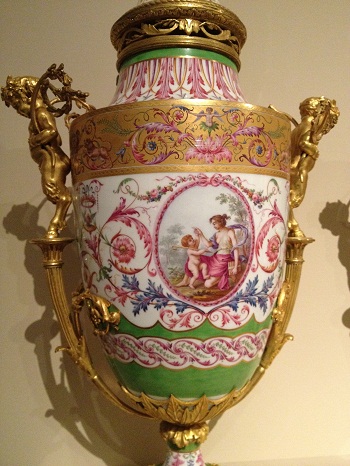
Detail of one vase
Displaying a stronger neoclassical style, however, is the frame of the armchair, which was designed by Georges Jacob, cabinetmaker to Napoleon. In France, Napoleon commandeered classicism to ally his self-proclaimed appointment as Emperor with the power and glory of ancient Greek and Roman leaders. As a result, the objects that he commissioned were designed with neoclassical scrolled arms, egg and dart molding, and fluted tapered legs. The pair of vases, made by Pierre-Philippe Thomire, who was named by Napoleon as Engraver to the Emperor, also possesses strong neoclassical elements with the depiction of a mythological scene and gilded mounts with putti.
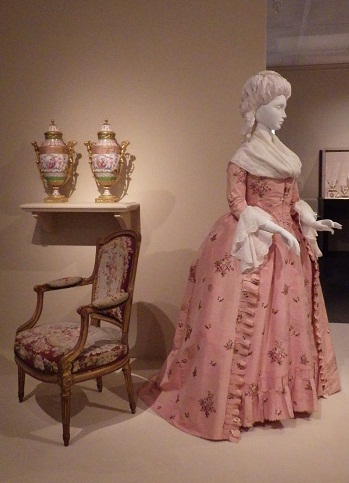
Armchair with carved wood frame, pair of vases with gilded bronze mounts, and a view of the robe à l’anglaise
The tapestries and costume ensemble displayed in this decorative arts gallery will be replaced recurrently with similar objects from the costume and textiles collection, as textiles are extremely fragile and sensitive to light. This means that the public can enjoy viewing other costume and textile rotations in this and other museum galleries in the future. You can view other costume and textiles currently on display throughout the museum online.
Elizabeth Williams, Assistant Curator, Decorative Arts and Design, and Clarissa Esguerra, Assistant Curator, Costume and Textiles



